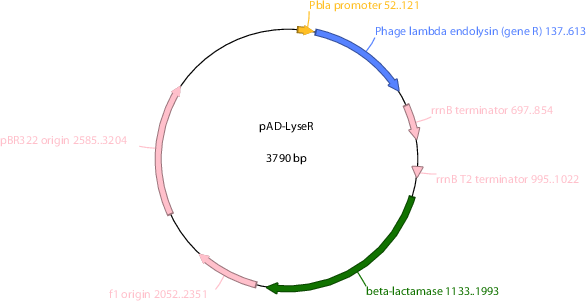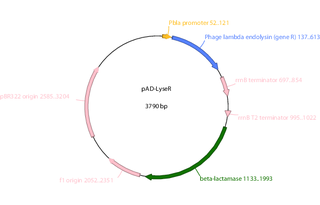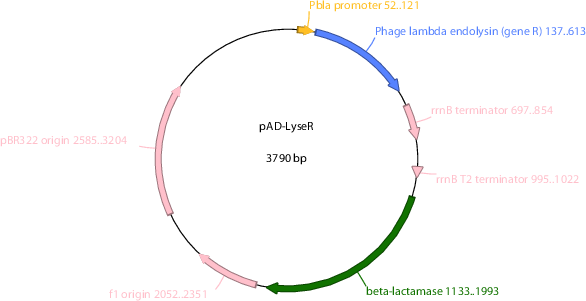-
PurposeFor autolysate production in E. coli BL21-Gold (DE3) strain: constitutively expresses phage lambda endolysin (gene R)
-
Depositing Lab
-
Sequence Information
Ordering
| Item | Catalog # | Description | Quantity | Price (USD) | |
|---|---|---|---|---|---|
| Plasmid | 99244 | Standard format: Plasmid sent in bacteria as agar stab | 1 | $85 | |
Backbone
-
Vector backbonepPro24
-
Backbone manufacturerJay Keasling lab
- Total vector size (bp) 3790
-
Vector typeBacterial Expression
Growth in Bacteria
-
Bacterial Resistance(s)Ampicillin, 100 μg/mL
-
Growth Temperature37°C
-
Growth Strain(s)BL21-Gold (DE3)
-
Growth instructionsUse 24% glycerol (w/v) in glycerol stocks to avoid cell lysis upon a freeze-thaw cycle.
-
Copy numberHigh Copy
Gene/Insert
-
Gene/Insert namephage lambda gene R
-
Alt namephage lambda endolysin
-
Speciesphage lambda
-
Insert Size (bp)474
-
Entrez GeneR (a.k.a. lambdap75)
- Promoter beta-lactamase promoter
Cloning Information
- Cloning method Gibson Cloning
- 5′ sequencing primer CCACATAGCAGAACTTTAAAAGTGCT
- 3′ sequencing primer CCG GGA GCT GCA TGT GTC AGA GG (Common Sequencing Primers)
Resource Information
-
Supplemental Documents
-
Article Citing this Plasmid
Terms and Licenses
-
Academic/Nonprofit Terms
-
Industry Terms
- Not Available to Industry
Trademarks:
- Zeocin® is an InvivoGen trademark.
Depositor Comments
pAD-LyseR plasmid in BL21-Gold (DE3) strain is used for producing autolysate for in vitro transcription-translation reactions.
These plasmids were created by your colleagues. Please acknowledge the Principal Investigator, cite the article in which the plasmids were described, and include Addgene in the Materials and Methods of your future publications.
-
For your Materials & Methods section:
pAD-LyseR was a gift from Jeff Hasty (Addgene plasmid # 99244 ; http://n2t.net/addgene:99244 ; RRID:Addgene_99244) -
For your References section:
Rapid and scalable preparation of bacterial lysates for cell-free gene expression. Didovyk A, Tonooka T, Tsimring L, Hasty J. ACS Synth Biol. 2017 Aug 10. doi: 10.1021/acssynbio.7b00253. 10.1021/acssynbio.7b00253 PubMed 28795570





